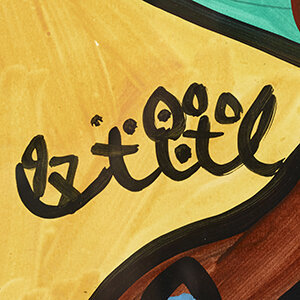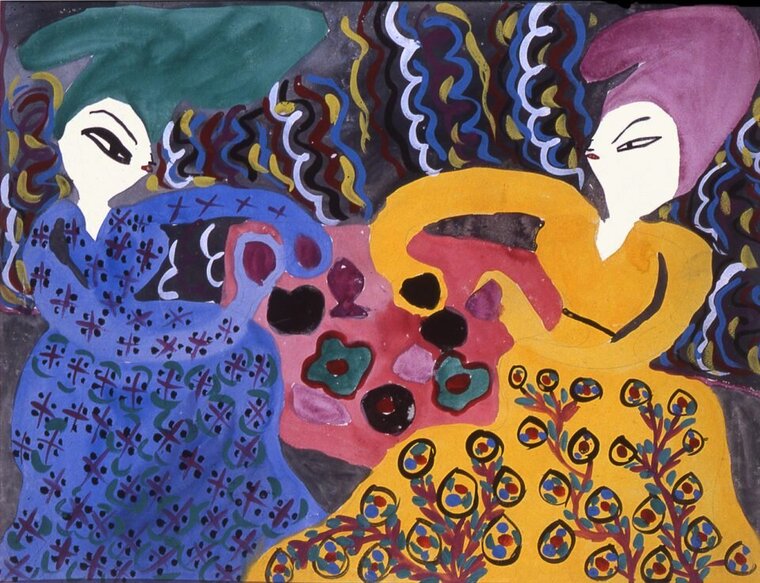


Last updated on Tue 9 January, 2018


EXHIBITION PRESENTS PAINTINGS BY
RENOWNED SELF-TAUGHT ALGERIAN ARTIST
IN THE U.S. FOR FIRST TIME
January 9–March 31, 2018
Contact: Ally Mintz
[email protected]
212/998-6782
New York University’s Grey Art Gallery is pleased to present the first North American exhibition of the work of self-taught Algerian artist Baya Mahieddine (1931–1998), who chose to be known by her first name only. On view from January 9 through March 31, 2018, in the Grey’s Lower Level Gallery, Baya: Woman of Algiers comprises some 20 gouache paintings, all shown for the first time in the U.S. Though championed by key members of the Parisian avant-garde—such as André Breton, Henri Matisse, and Pablo Picasso—and celebrated in Algeria, France, and the Middle East, Baya has yet to gain greater international recognition. This groundbreaking show reexamines Baya’s career within contemporary, feminist, outsider, Surrealist, and Maghreb post-colonial art contexts, shedding new light on her work. Baya: Woman of Algiers is curated by Natasha Boas and features works drawn from the Maeght Family Collection, Paris. Also included are several Madoura ceramics by Picasso and a video by London-based French-Algerian artist Zineb Sedira
Exhibition
Baya Mahieddine was born Fatma Haddad in 1931 outside Fort de l’Eau (today Bordj el-Kiffan), a suburb of Algiers, into a small rural tribe of mixed Kabyle and Arab heritage. Orphaned at the age of five, she lived with her grandmother for the next five years until her adoption by Marguerite Caminat Benhoura, a French citizen residing in Algiers. With Benhoura’s encouragement, Baya began making ceramics and paintings. While in Algiers in 1946, prominent art dealer Aimé Maeght met Baya through the French artist Jean Peyrissac, then living in the Casbah. Impressed by what he saw, Maeght, with Surrealist artist André Breton, organized Baya’s first major exhibition, at the Galerie Maeght in Paris in 1947; she was sixteen years old at the time. Included in that exhibition were the gouaches that will be on view in Baya: Woman of Algiers at the Grey. Baya’s colorful depictions of women, vibrant patterns, and bright palette soon drew the attention of Georges Braque, Matisse, and Picasso, among others.
In the years leading up to the Maeght exhibition, the French artistic community was pursuing a renewed interest in non-Western folk art, including masks and textiles. Within this context, Baya’s work was celebrated as both “Orientalist” and childlike. She quickly won critical accolades. Breton included her work in the Second Surrealist Exhibition in 1947 and wrote the preface for Galerie Maeght’s catalogue that same year, noting “I speak, not like so many others in order to lament an end, but to promote a beginning, and of this beginning, Baya is queen.” Critic and author Edmonde Charles-Roux’s review of the Maeght show in French Vogue featured a large photograph of Baya and made her the talk of the town.
While artists and art historians have classified Baya’s work as outsider, naïve, and Surrealist, she herself rejected Western art-historical terminology and institutional constraints. In her adoptive mother’s home, Baya lived among paintings by Matisse, but she later expressed a desire to distance herself from his color palette. Instead, she experimented with turquoise blue and Indian pink, colors she associated with women’s traditional clothing from her native Kabylie, a region in northern Algeria populated by Berbers. Her work is deeply indebted to her North African heritage and to the natural world around her. Intricate and imaginative, her paintings intertwine female figures with birds, fish, and flowers formed by recurring patterns that recall Arabic calligraphy, Islamic art, and Oriental carpets. As evidenced in her work, Baya created her own artistic language, fusing French Modernism with Maghreb folklore.
At Galerie Maeght, Picasso discovered the young Baya’s work, including several of her ceramics. He began experimenting with clay, and soon he was producing a large number of ceramic sculptures. Attributing this new direction to Baya’s influence, he worked with her on a series of works at the Madoura pottery workshop in Vallauris, a small town in the southeast of France. Featured in Baya: Woman of Algiers are four Madoura ceramics by Picasso from the Grey Art Gallery, New York University Art Collection. When Picasso embarked on his seminal Women of Algiers painting series in 1954, he, once again, cited Baya as an inspiration.
“Baya proposes an alternate mode of seeing,” observes guest curator Natasha Boas. “Her female figures’ faces are often depicted as flat empty spaces that are delineated only in the loose outline of an eye, which resembles the inverted Arabic character transliterated as ‘H.’ This suggests a more subversive interpretation of her work, of the visual strategies she invented to disrupt vanguard male imagery and question exoticized Western representations of North African women, such as Delacroix’s Women of Algiers in their Apartment (1834). In her work, Baya unabashedly presents a world without men.”
Throughout her career, Baya remained loyal to her own unique vision. While she shares an interest in exploring dreams and the unconscious with Surrealist artists, and her references to Arab-Kabyle culture and folklore are culturally specific, she also introduced entirely new visual vocabularies. Baya: Woman of Algiers contributes to present-day dialogues on self-taught artists, alternative modernisms, and women artists whose works have previously been overlooked. Commenting on Baya’s impact on our contemporary post-colonial world, the influential French-Algerian novelist and feminist Assia Djebar exclaimed: “Baya, the first in a chain of sequestered women, whose blindfold has, all of a sudden, fallen to the ground. Baya, saved by a miracle!”
The exhibition’s coda presents Zineb Sedira’s video work Mother Tongue (2002). Born into an Algerian family in Paris in 1963, Sedira is known for her haunting photographs and video installations. Mother Tongue features interviews she conducted with her mother and her daughter. The dialogues–in Arabic, French, and English–reveal aspects of one family’s immigration over three generations, and raise questions about memory, displacement, and the transmission of history. Exhibited in tandem with Baya’s paintings, Mother Tongue offers a framework for the discussion of cultural translation and feminist genealogies in a contemporary global context.
Exhibition Catalogue
Baya: Woman of Algiers will be accompanied by a four-color illustrated catalogue with an essay by Natasha Boas, an art historian and independent curator based in Paris and San Francisco, and features a contribution by the Egyptian writer and director Menna Ekram. Also included will be reprinted and translated texts by André Breton and the late Assia Djebar, an Algerian novelist, translator, and filmmaker, and former Silver Professor of Francophone literature at New York University. The book will be published by the Grey Art Gallery, NYU.
Sponsorship
Baya: Woman of Algiers is organized by the Grey Art Gallery, New York University, and curated by Natasha Boas. Its presentation is made possible in part by the generous support of the Cultural Services of the French Embassy, Bellatrix Hubert, Gina Pell, and the Scheherazade Art Fund. Additional support is provided by NYU’s Department of French Literature, Thought and Culture; the Grey Art Gallery’s Director’s Circle, Inter/National Council, and Friends; and the Abby Weed Grey Trust. In-kind support is provided by Galerie Maeght, Paris, and Jules Maeght Gallery, San Francisco.
About the Grey Art Gallery
The Grey Art Gallery is New York University’s fine arts museum, located on historic Washington Square Park in New York City’s Greenwich Village. It offers the NYU community and the general public a dynamic roster of engaging and thought-provoking exhibitions, all of them enriched by public programs. With its emphasis on experimentation and interpretation, and its focus on studying art in its historical, cultural, and social contexts, the Grey serves as a museum-laboratory for the exploration of art’s environments.
Exhibitions organized by the Grey have encompassed all the visual arts: painting, sculpture, drawing and printmaking, photography, architecture and decorative arts, video, film, and performance. In addition to producing its own exhibitions, which often travel to other venues in the United States and abroad, the Gallery hosts traveling shows that might otherwise not be seen in New York and produces scholarly publications that are distributed worldwide.
General Information
Grey Art Gallery, New York University
100 Washington Square East, New York, NY 10003
Tel: 212/998-6780, Fax: 212/995-4024
E-mail: [email protected]
Website: greyartgallery.nyu.edu
Hours
Tuesday, Thursday, Friday: 11 am–6 pm
OPEN LATE Wednesday: 11 am–8 pm
Saturday: 11 am–5 pm
Sunday, Monday, and major holidays: Closed
Admission
Suggested donation: $5; NYU students, faculty, and staff: free of charge
Join us in our endless discovery of modern and contemporary Arab art